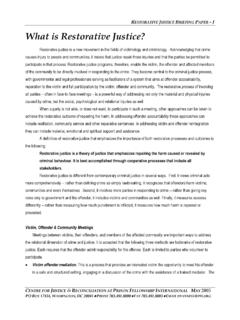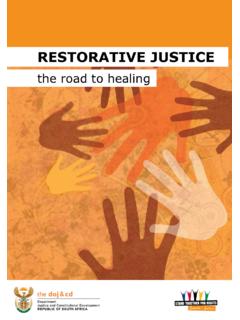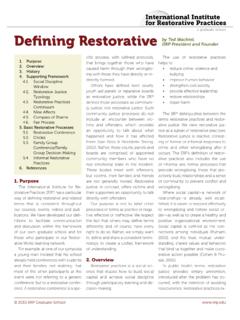Transcription of RESTORATIVE JUSTICE, THERAPEUTIC JURISPRUDENCE …
1 RESTORATIVE justice , THERAPEUTIC JURISPRUDENCE . AND THE RISE OF EMOTIONALLY INTELLIGENT justice . MICHAEL S KING*. [Over the past 20 years, court and legal practices have changed due to the influence of more emotionally intelligent and less adversarial approaches to resolving legal disputes. RESTORATIVE justice encounters involving victims and offenders discussing what happened, why it happened and what reparation can be made have promoted victim wellbeing and offender rehabilitation. Therapeu- tic JURISPRUDENCE has suggested reforms to minimise the law's negative effects on wellbeing and to promote its wellbeing-related goals such as crime victims' safety and health, injured workers'. rehabilitation and broken families' welfare. Both see the management of emotions and professionals'. interpersonal skills as important in dispute resolution. This article argues that judging and legal practice should include exercising intrapersonal and interpersonal skills, and that legal education should train legal professionals accordingly.]
2 ]. CONTENTS. I Introduction .. 1097. II Emotional 1098. III RESTORATIVE justice ..1101. A The Nature and Development of RESTORATIVE B Primary RESTORATIVE justice Practices ..1104. C RESTORATIVE justice Outcomes ..1106. D Emotions and the Dynamics of RESTORATIVE justice E Criticisms of RESTORATIVE IV THERAPEUTIC A The Nature and Scope of THERAPEUTIC JURISPRUDENCE ..1111. B Criticisms of THERAPEUTIC JURISPRUDENCE ..1115. V Emotional Intelligence, THERAPEUTIC JURISPRUDENCE , RESTORATIVE justice and the Law ..1118. A B Legal Practice ..1122. C Legal Education ..1124. VI * BJuris, LLB (Hons) (UWA), MA, PhD (MUM); Senior Lecturer, Faculty of Law, Monash University; Formerly Perth Drug Court Magistrate and Geraldton Magistrate. The author would like to thank the anonymous referees for their helpful comments. 1096. 2008] RESTORATIVE justice and THERAPEUTIC JURISPRUDENCE 1097. I INTRODUCTION. In his 2002 presidential address to the American Society of Criminology, Lawrence Sherman spoke of an emotionally intelligent justice , in which the central tools will be inventions for helping offenders, victims, communities, and officials manage each others' emotions to minimize harm.
3 '1 Although these comments suggested a future direction for criminology and the criminal justice system, they are descriptive of a wider trend that is gaining momentum not only in the justice system as a whole, but also in dispute resolution processes in schools, community organisations and workplaces. This trend has been called non-adversarial justice ' or the comprehensive law movement'.2 Both terms describe core features of this development but neither is entirely satisfactory: approaches such as procedural justice and THERAPEUTIC JURISPRUDENCE aim to enhance both adversarial and non-adversarial processes, and not all non-adversarial approaches are Non-adversarial or comprehensive approaches to justice include alternative or appropriate dispute resolution, problem-solving courts, indigenous sentencing courts, diversion programs, holistic law, preventive law, procedural justice , creative prob- lem-solving, RESTORATIVE justice and THERAPEUTIC JURISPRUDENCE . Non-adversarial justice uses processes that are generally more comprehensive and psychologically attuned than conventional justice system processes.
4 Psycho- logically attuned approaches include an appreciation of the role of emotion in legal problems, problem resolution processes and legal outcomes. The central tools and inventions of these approaches are communicative techniques incorpo- rating understanding, feelings and empathy, and the application of a broad definition of legal problems and outcomes. These techniques and approaches have significant implications for the law, the way judges, magistrates and lawyers undertake their work and legal education. Although the traditional focus in training lawyers and members of the judiciary has been on knowledge of the law, skills in fact-finding and application of the law, key non-adversarial approaches suggest that emotional intelligence and interpersonal skills are also important parts of their roles. THERAPEUTIC JURISPRUDENCE and RESTORATIVE justice assert that emotional issues can be intimately related to a dispute's development or to harmful behaviour, and that effective management of emotions is important in resolution processes.
5 THERAPEUTIC JURISPRUDENCE examines the law's effect on the wellbeing . 1 Lawrence W Sherman, Reason for Emotion: Reinventing justice with Theories, Innovations, and Research The American Society of Criminology 2002 Presidential Address' (2003) 41. Criminology 1, 6. 2 Arie Freiberg, Non-Adversarial Approaches to Criminal justice ' (2007) 16 Journal of Judicial Administration 205; Susan Daicoff, The Role of THERAPEUTIC JURISPRUDENCE within the Compre- hensive Law Movement' in Dennis P Stolle, David B Wexler and Bruce J Winick (eds), Practic- ing THERAPEUTIC JURISPRUDENCE : Law as a Helping Profession (2000) 465; Michael S King et al, Non-Adversarial justice (2009) (forthcoming). 3 See generally Michael S King, Towards a More Comprehensive Resolution of Conflict: The Role of RESTORATIVE justice ' (Paper presented at the RESTORATIVE justice : Bringing justice and Community Together Conference, Melbourne, 14 May 2008) < >. 1098 Melbourne University Law Review [Vol 32. including the emotional wellbeing of its It recommends law reform based on behavioural science to minimise negative effects and to promote positive effects on wellbeing.]
6 RESTORATIVE justice asserts that harmful behaviour, whether related to legal action or not, can cause not only material damage but also emotional or psychological harm that must be healed if the problem is to be comprehensively The primary healing mechanism is a mediated encounter between victim and offender whereby the emotions of each may be expressed and soothed by discussing the events, their effects and what the offender might do to make The increased appreciation of the significance of emotions in the emergence and resolution of legal problems mirrors developments in diverse disciplines and in the wider community, such as the growing influences of psychology and of the concept of emotional II E M O T I O N A L I N T E L L I G E N C E. Emotions affect how we perceive and behave towards other people. They commonly bring about coordinated changes in physiology, motor readiness, behavior, cognition, and subjective experience.'8 The significance of emotions to human wellbeing and behaviour has been considered by western and eastern philosophical traditions for several thousands of They are also an important topic in psychology.
7 With the increase in scientific and popular interest in the role of emotions, some recent theories have endeavoured to link emotions to intelligence. The concept of emotional intelligence has been promoted within the academic community by the work of Peter Salovey and John Mayer and within popular culture by the work of Daniel The concept of emotional intelligence emerged at a time when the idea of more than one intelligence was gaining support. In the early 1980s, Howard Gardner proposed a theory of multiple intelligences which are mental skills in particular areas of human functioning, such as logical, linguistic, musical and spatial 4 David B Wexler, THERAPEUTIC JURISPRUDENCE : The Law as a THERAPEUTIC Agent (1990); David B. Wexler and Bruce J Winick (eds), Essays in THERAPEUTIC JURISPRUDENCE (1991). A THERAPEUTIC JURISPRUDENCE bibliography is available on the website of the International Network on Thera- peutic JURISPRUDENCE : The University of Arizona James E Rogers College of Law, TJ Bibliogra- phy Complete List (2002) International Network on THERAPEUTIC JURISPRUDENCE < >.
8 For Australasian resources, see the website of the Australasian THERAPEUTIC JURISPRUDENCE Clearinghouse: Australasian THERAPEUTIC JURISPRUDENCE Clearinghouse, Resources (2008) The Australasian Institute of Judicial Administration < >. 5 Daniel W Van Ness and Karen Heetderks Strong, Restoring justice (2nd ed, 2002) 38. 6 Ibid 55 78. 7 See, eg, Daniel Goleman, Emotional Intelligence (1995). 8 John D Mayer, Richard D Roberts and Sigal G Barsade, Human Abilities: Emotional Intelli- gence' (2008) 59 Annual Review of Psychology 507, 510 (citations omitted). 9 See, eg, Keith Oatley, Emotions: A Brief History (2004); Michael S King, Natural Law and the Bhagavad-Gita: The Vedic Concept of Natural Law' (2003) 16 Ratio Juris 399. 10 See, eg, John D Mayer and Peter Salovey, The Intelligence of Emotional Intelligence' (1993) 17. Intelligence 433; Goleman, Emotional Intelligence, above n 7. 2008] RESTORATIVE justice and THERAPEUTIC JURISPRUDENCE 1099. For example, linguistic intelligence relates to the skill in using language, such as to persuade, explain or remember.
9 Gardner also suggested that there are interpersonal and intrapersonal intelli- gences which relate in part to understanding and managing Intraper- sonal intelligence involves being aware of one's feelings and using them to understand and guide one's behaviour. Interpersonal intelligence involves being aware of others' emotional states, motivations and intentions, and being able to use this knowledge to, for example, influence their behaviour. These two intelligences overlap with the concept of emotional intelligence as well as with the concept of social intelligence the capacity to interact wisely with other Mayer and Salovey defined emotional intelligence as: a type of social intelligence that involves the ability to monitor one's own and others' emotions, to discriminate among them, and to use the information to guide one's thinking and actions. The scope of emotional intelligence includes the verbal and nonverbal appraisal and expression of emotion, the regulation of emotion in the self and others, and the utilization of emotional content in prob- lem They later refined the concept, explaining that it encompasses four main areas.
10 Perceiving, understanding, using and managing Their theory falls into what John Mayer, Richard Roberts and Sigal Barsade call integrative approaches to emotional intelligence, which integrate the different aspects into a comprehensive They distinguish these approaches from those that focus on specific abilities related to emotional intelligence such as perceiving emo- tions, the use of emotions in thinking and reasoning about There are also mixed models that include factors not specifically involved in perceiving, understanding, using and managing For example, Reuven Bar-On links emotional intelligence to social intelligence, defining them as a multifactorial array of interrelated emotional, personal, and social abilities that influence our overall ability to actively and effectively cope with daily demands and pressures.'19 Its components are accurate self-regard, emotional self-awareness, assertiveness, empathy, interpersonal relationship, stress toler- ance, impulse control, reality testing, flexibility and 11 Howard Gardner, Frames of Mind: The Theory of Multiple Intelligences (1st ed, 1983).








